2010/11 Scottish Crime and Justice Survey: Drug Use
This report presents findings from the Scottish Crime and Justice Survey 2010/11 Drug Use module. The report provides information on the experience and prevalence of illicit drug use amongst the general adult population in Scotland.
2 Prevalence of Illicit Drug Use in Scotland
Self-reported drug use
The SCJS 2010/11 estimated that:
- Just under one in four (23.7%) adults reported taking one or more illicit drug at some point in their lives (ever), even if it was a long time ago;
- One in fifteen (6.6%) adults reported using one or more illicit drug in the last year, i.e. the 12 months prior to the survey interview;
- One in twenty eight (3.5%) adults reported using one or more illicit drug in the last month, i.e. the month prior to the survey interview.
Cannabis was by far the drug most commonly reported in any of the 3 time periods asked about with around one in seventeen (5.6%) adults reporting cannabis use in the last year. Cocaine and ecstasy were the next most commonly reported drugs used after cannabis in the last year (1.9% and 1.4% respectively).
Demographic variations
The percentage of men (9.5%) who reported using one or more illicit drug in the last year was more than twice as high as the percentage of women (3.9%).
Use of illicit drugs in the last year was higher among 16-24 year olds (20.3%) than for 25-44 year olds (9.2%) and lower among 45-59 year olds, decreasing further among those aged 60 or over.
Trends in self-reported drug use over time
Self-reported drug use among adults aged 16 or over in Scotland has decreased between 2008/09 and 2010/11. 6.6% of adults reported using drugs in the last year in 2010/11 compared with 7.2% in 2009/10 and 7.6% in 2008/09. Similarly 3.5% of adults reported using drugs in the last month in 2010/11 compared with 4.2% of adults in 2009/10 and 4.4% of adults in 2008/09. These decreases are statistically significant.
Trends in self-reported drug use compared with England and Wales
Fewer 16-59 year olds reported that they had taken any illicit drug at some point in their lives in Scotland than across England and Wales, while the percentages of adults taking any illicit drug in the last year or last month were similar.
Being offered drugs
Around one in eight (11.6%) adults reported that someone had offered to give or sell them at least one type of illicit drug in the last year. 43.4% of these had used an illicit drug in the last year and 55.9% had not.
This chapter looks at the prevalence of illicit drug use in Scotland, including the overall extent of drug use, use by composite drug group and legal classification, as well as use of the individual drugs asked about. It then moves on to examine demographic, socio-economic and geographical variations in prevalence of drug use. The chapter then looks at the likelihood of being offered illicit drugs, and concludes by looking at the prevalence of the 'new' previously legal drugs.
Comparisons are made over time using the SCJS data from 2008/09 and 2009/10, and between Scotland and England and Wales (together) using the British Crime Survey (BCS) 2010/11, where relevant.[10]
The SCJS 2010/11 provides estimates of the percentage of adults, aged 16 or over, in Scotland who report that they have used illicit drugs based on answers provided to 3 questions covering 3 periods of time (ever, in the last year and in the last month):[11]
- Just under one in four (23.7%) adults reported taking one or more illicit drug at some point in their lives (ever), even if it was a long time ago;
- One in fifteen (6.6%) adults reported using one or more illicit drug in the last year, i.e. the 12 months prior to the survey interview;
- One in twenty eight (3.5%) adults reported using one or more illicit drug in the last month, i.e. the month prior to the survey interview.
Comparisons with the SCJS 2008/09 and 2009/10 help to set these findings in context.
- Self-reported drug use among adults age 16 and over in Scotland has decreased between 2008/09 and 2010/11 (Figure 2.1);
- 23.7% of adults reported using drugs ever in 2010/11 compared with 25.2% in 2009/10 and 25.6% in 2008/09. The decrease between 2010/11 and both 2008/09 and 2009/10 is statistically significant;
- 6.6% of adults reported using drugs in the last year in 2010/11 compared with 7.2% in 2009/10 and 7.6% in 2008/09. The decrease between 2010/11 and 2008/09 is statistically significant;
- Similarly 3.5% of adults reported using drugs in the last month in 2010/11 compared with 4.2% of adults in 2009/10 and 4.4% of adults in 2008/09. The decrease between 2010/11 and both 2008/09 and 2009/10 is statistically significant.
Figure 2.1: % of adults aged 16 or over reporting use of drugs ever, in the last year and in the last month over time
SCJS 2008/09; SCJS 2009/10; SCJS 2010/11.
Base: Adults aged 16 or over (2008/09 10,962; 2009/10 13,409; 2010/11 10,977).
Variable name: QEVE; Q12M; Q1M.
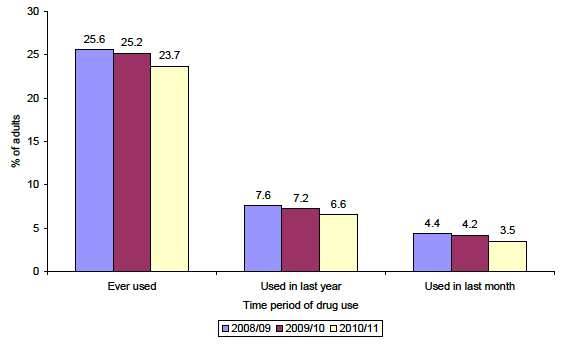
Prevalence of drug use among adults aged 16-59 in the last year has steadily decreased from that reported in the Scottish Crime and Victimisation Survey (SCVS) in 2006. 12.6% of adults reported using drugs in the last year in 2006 compared to 10.3% in the SCJS 2008/09, 9.8% in the SCJS 2009/10 and 9.1% in the SCJS 2010/11.
Comparisons with the BCS 2010/11, based on 16-59 year olds, provide further context to these Scotland findings (reported in Smith et al., 2011).
Self-reported illicit drug use ever in Scotland (SCJS 2010/11) was significantly lower than across England and Wales among 16-59 year olds (31.4% compared with 36.3% for England and Wales).
However, self-reported illicit drug use in the last year and in the last month was similar (not significantly different) in Scotland to that across England and Wales. In England and Wales 8.8% of 16-59 year olds reported taking drugs in the last year and 4.8% said they had in the last month (compared with 9.1% and 4.8% respectively in Scotland).
2.4 Self-reported drug use by composite group and Class of drug [12]
Looking in more detail at self-reported drug use by composite drug group, i.e. classifying them by shared characteristics, Figure 2.2 shows that:
- One in eight (12.5%) adults reported that they had taken stimulant drugs (cocaine, crack, crystal meth, ecstasy, amphetamines, poppers) at some point in their lives while 2.8% had taken at least one of these drugs in the last year and 1.2% in the last month;
- Around one in thirteen (7.5%) adults reported use of psychedelic substances (including LSD, magic mushrooms or ketamine), at some point in their lives. Less than 1% of adults aged 16 or over reported using a drug from this composite drug group either in the last year or the last month (0.6% and 0.2% respectively);
- Just under one in twenty one (4.6%) adults reported ever using downers or tranquilisers (temazepam or valium), with 1.1% having used either of these in the last year and 0.4% in the last month;
- Use of opiates (heroin and methadone) was lower. 1.0% of adults reported taking either of these drugs at some point in their lives, and less than 0.5% had taken opiates either in the last year or the last month (0.3% and 0.2% respectively).[13]
Figure 2.2: % of adults aged 16 or over reporting use of drugs by composite group ever, in the last year and in the last month
SCJS 2010/11.
Base: Adults aged 16 or over (10,977).
Variable name: QEVE; Q12M; Q1M.
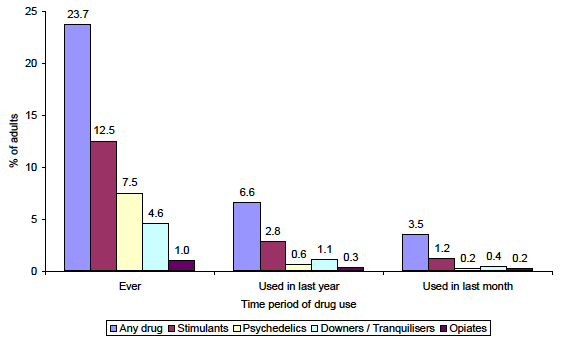
In respect of legal classification, findings from the SCJS 2010/11 showed that (Figure 2.3):
- Around one in nine (11.7%) adults aged 16 or over reported use of Class A drugs at some point in their lives, with 2.6% reporting use of Class A drugs in the last year and 1.2% in the last month;
- Almost a quarter (22.2%) of adults reported use of Class B drugs at some point in their lives. Use of Class B drugs was dominated by cannabis use, the drug adults most commonly reported taking (21.6% reported ever using cannabis). 5.7% of adults aged 16 or over had taken Class B drugs in the last year and 3.0% in the last month;
- Around one in twenty (5.2%) adults aged 16 or over reported use of Class C drugs ever, with 1.2% having done so in the last year and 0.5% in the last month.
Figure 2.3: % of adults aged 16 or over reporting use of drugs by Class ever, in the last year and in the last month
SCJS 2010/11.
Base: Adults aged 16 or over (10,977).
Variable name: QEVE; Q12M; Q1M.
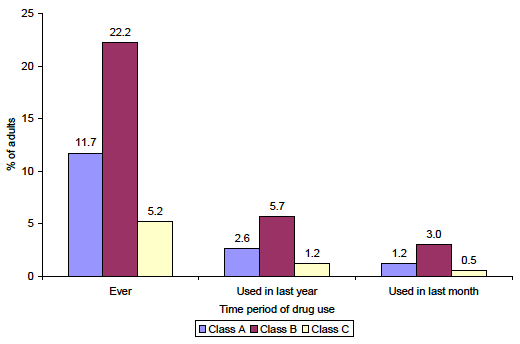
2.5 Self-reported drug use by specific drug
Reported drug use ever, in the last year and in the last month by adults aged 16 or over followed similar patterns for individual drugs. Patterns of use for all drugs over the three time periods are discussed below. Figure 2.4, Figure 2.5 and Figure 2.6 show findings for all three time periods individually. More detailed discussion of drug use in the last month is also provided in Chapter 3.
The SCJS 2010/11 clearly shows that cannabis was the most commonly reported drug by adults in any of the 3 time periods asked about.
- 21.6% of adults had taken cannabis at some point in their lives, around three times as many as the next most commonly reported drugs (amphetamines, ecstasy, cocaine and poppers - all around 7%):
- Around one in seventeen (5.6%) adults reported using cannabis in the last year, which represents 83.6% of adults using any illegal drug in the last year;
- 3.0% of adults aged 16 or over reported using cannabis in the last month;
- The next most common drugs that people reported they had ever taken were amphetamines (7.8%), ecstasy (7.2%), cocaine (7.1%) and poppers (6.4%):
- In the last year, 1.9% of adults reported that they had used cocaine compared with 1.4% who reported ecstasy use, 0.9% who reported amphetamine use and 0.6% who reported using poppers over the same time period;
- Reported use of cocaine in the last month was 0.7% compared with 0.6% for ecstasy, 0.4% for amphetamines and 0.2% for poppers;
- Reported use of the psychedelic drugs, magic mushrooms and LSD, was similar for each time period:
- o Around one in twenty adults reported using magic mushrooms (5.2%) and LSD (4.9%) at some point in their lives. Less than 0.5% of adults reported using either of these drugs in the last year or last month;
- For downers / tranquilisers, reported use of valium was greater than temazepam over all three time periods:
- 3.9% of adults had used valium at some point in their lives compared with 2.0% for temazepam;
- 1.0% of adults had used valium in the last year and 0.4% had done so in the last month compared with 0.3% and 0.1% who had used temazepam in the respective periods;
- Use of glues, solvents, gas or aerosols was reported by 2.2% of adults aged 16 or over at some point in their lives, while use in the last year was 0.2% and use in the last month was lower than 0.1%;
- Ketamine use ever was reported by 1.2% of adults, reducing to 0.3% in the last year and 0.1% in the last month. Use of anabolic steroids ever and in the last year (0.3% and 0.1% respectively), and crystal meth (0.3%) ever was reported by fewer adults;[14]
- Less than 1% of adults reported using heroin (0.8%), crack (0.8%) or methadone (0.7%) at some point in their lives, with 0.2% or fewer having used these in either the last year or last month.
Results for individual drugs are shown in the 3 charts that follow and each covers a separate time period. The drugs in each chart are ordered consistently, from highest to lowest percentage ever used (i.e. based on Figure 2.4) and the same scale (0% - 25%) has been used for the y axis in each chart to aid comparison.
Firstly, Figure 2.4 shows which drugs adults, aged 16 or over, reported using at some point in their lives:
- Three times as many adults reported that they had used cannabis at some point in their lives (21.6%) compared with amphetamines (7.8 %) or ecstasy (7.2%), which were the next most commonly used drugs ever. This illustrates the dominance of cannabis highlighted previously.
Figure 2.4: % of adults aged 16 or over reporting drug use ever by drug used
SCJS 2010/11.
Base: Adults aged 16 or over (10,977).
Variable name: QEVE.
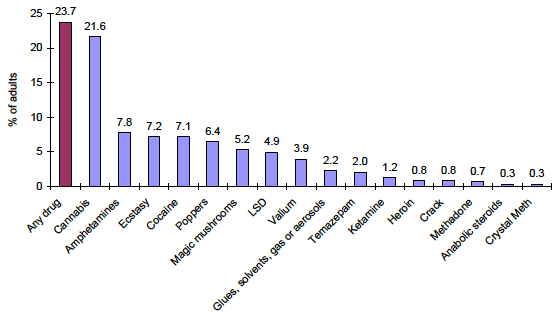
Figure 2.5 shows the drugs reported by adults in the last year:
- Cannabis remained the most commonly used drug (5.6%);
- The next most commonly used drugs were cocaine (1.9%) and ecstasy (1.4%);
- Around three times as many adults reported they had used cannabis in the last year than cocaine or ecstasy.
Figure 2.5: % of adults aged 16 or over reporting drug use in the last year by drug used [15]
SCJS 2010/11.
Base: Adults aged 16 or over (10,977).
Variable name: Q12M.
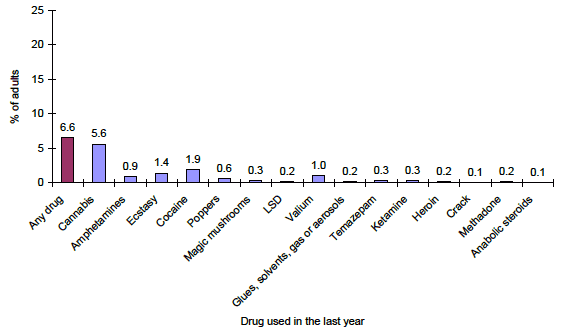
Finally, Figure 2.6 presents the drugs reported by adults in the last month:
- Cannabis was the most commonly used drug in the last month (i.e. the month prior to the survey interview)(3.0%);
- Cocaine and ecstasy were the next most commonly reported drugs in the last month (0.7% and 0.6% respectively);
- Between four and five times as many adults reported taking cannabis in the last month than reported taking cocaine or ecstasy.
Figure 2.6: % of adults aged 16 or over reporting drug use in the last month by drug used [16]
SCJS 2010/11.
Base: Adults aged 16 or over (10,977).
Variable name: Q1M.
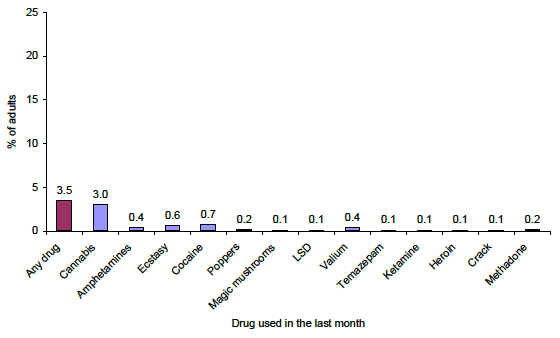
The ranking of Figure 2.5 and Figure 2.6 in order of highest to lowest percentage used ever highlights the relatively higher prevalence of taking cocaine and valium in the last year or the last month, compared with amphetamines, poppers, magic mushrooms and LSD which were relatively more likely to have been taken at some point in a person's life.
Figure 2.7 shows the percentage of adults who reported use of the most prevalent drugs over time in 2008/09, 2009/10 and 2010/11:
- Significantly fewer adults reported taking cocaine in the last year in the SCJS 2010/11 (1.9%) compared with in 2008/09 (2.7%), but the difference between 2010/11 and 2009/10 (2.1%) is not significant, meaning that cocaine use in the last year has remained stable. This pattern was repeated for cocaine use in the last month (0.7% 2010/11; 0.7% 2009/10; 1.2% 2008/09).
- The proportion of adults in Scotland who reported ecstasy use in the last year is significantly lower in the SCJS 2010/11 (1.4%) compared with both 2009/10 (1.9%) and 2008/09 (1.8%).
- Significantly fewer adults aged 16 and over reported taking poppers in the last year in the SCJS 2010/11 (0.6%) compared with both 2009/10 (0.9%) and 2008/09 (1.0%).
Figure 2.7: % of adults aged 16 or over reporting use of the most prevalent drugs in the last year over time [17]
SCJS 2008/09; SCJS 2009/10; SCJS 2010/11.
Base: Adults aged 16 or over (2008/09 10,962; 2009/10 13,409; 2010/11 10,977).
Variable name: Q12M.
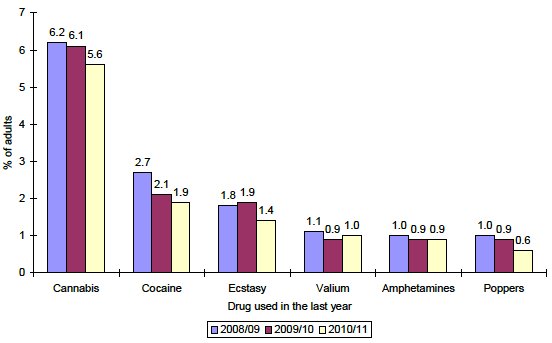
Findings from the SCJS 2010/11 can also be compared with results from the BCS 2010/11 for individual drug use. Although the overall difference in reported illicit drug use among 16-59 year olds in Scotland in the last year was not significantly different to England and Wales, use of a number of individual drugs was still significantly higher in Scotland than England and Wales. This included cannabis (7.7% of adults aged 16-59 in Scotland compared with 6.8% across England and Wales); cocaine (2.6% in Scotland; 2.1% in England and Wales) and ecstasy (1.9% in Scotland; 1.4% in England and Wales).
2.6 Variations in self-reported drug use
This section looks at the prevalence of self-reported illicit drug use by gender, age, and a series of other factors.
2.6.1 Variation by gender
Men reported higher levels of illicit drug use than women (Figure 2.8):
- Almost three in ten (29.1%) men reported taking an illicit drug at some point in their lives compared with less than two in ten (18.7%) women;
- Over the last year, more than twice the percentage of men (9.5%) than women (3.9%) reported taking an illicit drug, a pattern that was repeated for self-reported drug use in the last month (5.3% and 1.8% respectively).
Figure 2.8: Variation in self-reported drug use ever, in the last year and last month among adults aged 16 or over by gender
SCJS 2010/11.
Base: Adults aged 16 or over (adults 10,977; men 4,728; women 6,249).
Variable name: QEVE; Q12M; Q1M.
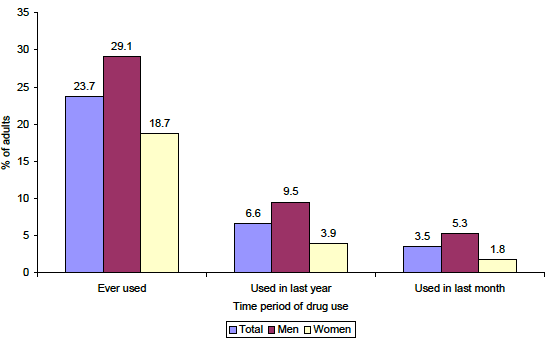
This gender difference also extended to composite drug groups, Class and individual drugs (see Tables A1.7 - A1.12 in Annex 1).
2.6.2 Variation by age
In terms of age, the youngest age groups in the SCJS reported the highest levels of drug use in the last year and in the last month compared with other age groups and prevalence decreased steadily with age:
- 16-24 year olds reported the highest levels of illicit drug use in the last year (20.3%), decreasing to 9.2% of those aged 25-44, 2.5% of 45-59 year olds and 0.2% of those aged 60 or older.
- In the last month, 9.8% of 16-24 year olds reported using illicit drugs decreasing to 5.1% of 25-44 year olds, 1.4% of 45-59 year olds and 0.1% of those aged 60 or over.
- Compared to 2008/09, drug use among 16-24 year olds has reduced from 23.5% to 20.3% in 2010/11. Drug use among 16-24 year olds in the last year has remained stable between 2009/10 (20.2%) and 2010/11.
However, as Figure 2.9 shows, a similar percentage of 16-24 year olds (37.2%) reported using illicit drugs at some point in their lives as did 25-44 year olds (38.1%), reflecting drug use in the past among these older adults. Reported use of illicit drugs in the last year and in the last month was higher for 16-24 year olds (20.3% and 9.8% respectively) than for 25-44 year olds (9.2% and 5.1% respectively).
Figure 2.9: Variation in drug use ever, in the last year and last month among adults aged 16 or over by age
SCJS 2010/11.
Base: Adults aged 16 or over (adults 10,977; 16-24 968; 25-44 3,298; 45-59 2,916; 60+ 3,793).
Variable name: QEVE; Q12M; Q1M.
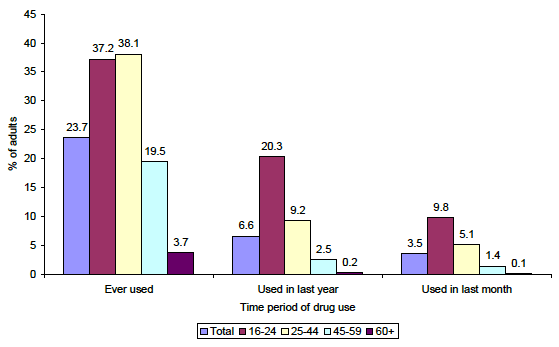
Those aged 25-44 were most likely to report that they had ever used stimulants, opiates, psychedelics, Class A or Class B drugs, though in the last year the younger age group (16-24 year olds) were more likely to report using all of these, with the exception of opiates (see Tables A1.4 and A1.5 in Annex 1).
2.6.3 Variation by gender and age
Examining drug use in the last year by gender within age shows a consistent pattern, with men in all age cohorts more likely to report using drugs, and a clear association between age and likelihood of use (Figure 2.10).
Figure 2.10: Variation in drug use in the last year among adults aged 16 or over of different age groups by gender
SCJS 2010/11.
Base: Adults aged 16 or over in each age range by gender (ranging from adults aged 60+ 3,793, to males aged 16-24 438).[18]
Variable name: Q12M.
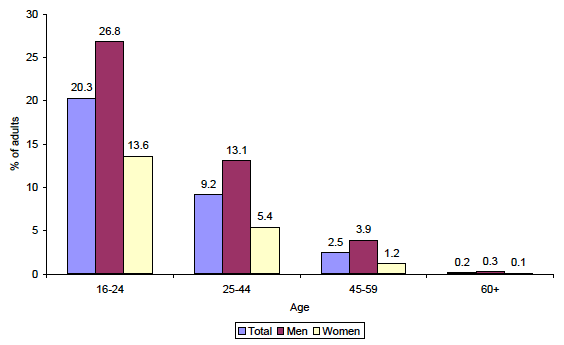
2.6.4 Variation in drug use by other factors
Variation in drug use in the last year among adults aged 16 or over was also investigated by other socio-economic, experiential and area factors. The fact that an association is identified between these factors and drug taking does not imply that one causes the other. Associations were investigated as simple one-to-one relationships rather than more complex statistical relationships that take into account links between factors that might be identified through statistical modelling.[19]
Factors where differences in drug use between sub-groups were identified included self-reported experience of being a victim of crime as measured by the SCJS 2010/11; socio-economic classification, as measured by Office for National Statistics Socio-Economic Classification (NS-SEC);[20] tenure; area deprivation [21] and urban rural classification.[22]
Associations identified that were statistically significant included:
- Victims of crime as measured by the SCJS 2010/11 were significantly more likely to report using illicit drugs in the last year (11.7% compared with 5.5% among non-victims);
- Those working in routine and manual occupations (9.6%) were significantly more likely to have taken illicit drugs in the last year than those who were not working or long-term unemployed (4.8%)[23] and those in managerial and professional occupations (4.8%). 5.9% of those in intermediate occupations had used any drug in the last year, which is also significantly less than those working in routine or manual occupations;
- Those living in private rented accommodation (14.5%) were more likely to report using any drug in the last year compared with those living in social rented housing (10.0%). Both of these groups were significantly more likely to report illicit drug use in the last year than owner-occupiers (4.1%);
- Those living in the 15% most deprived areas of Scotland were more likely to report using drugs in the last year than adults living elsewhere in Scotland (9.0% compared with 6.3% respectively);
- Those living in urban areas (7.2%) were significantly more likely to report using any drug in the last year than adults living in rural areas (4.4%).
2.7 Being offered drugs in the last year
The SCJS 2010/11 estimated that around one in nine (11.6%) adults in Scotland reported that someone had offered to give or sell them at least one type of illicit drug in the last year. The particular drugs offered showed similar patterns to levels of usage of different drugs.
Figure 2.11 shows the percentage of adults aged 16 or over who reported being offered at least one drug within composite drug groups and Class in the last year. It also shows the top three individual drugs that adults reported that they had been offered:[24]
- The drug most likely to have been offered to adults aged 16 or over was cannabis, offered to just under one in ten adults (9.3%), followed by cocaine (5.1%) and ecstasy (4.6%) respectively;
- Around one in thirteen (7.5%) adults had been offered stimulants and far fewer had been offered any of the other drug groupings: downers or tranquilisers (2.3%); psychedelics (2.2%); and opiates (1.3%);
- Around one in fourteen (7.3%) adults mentioned that they had been offered at least one Class A drug in the last year compared to 9.6% for Class B (reflecting Cannabis - 9.3% - being the most likely drug offered) and 3.1% for Class C.
Figure 2.11: % of adults aged 16 or over being offered drugs in the last year within type of drug
SCJS 2010/11.
Base: Adults aged 16 or over (10,977).
Variable name: QOF2.
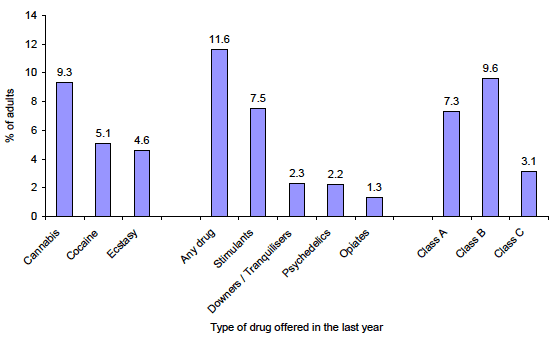
The percentage of adults being offered drugs in the last year has decreased between 2008/09 and 2010/11. 11.6% of adults reported that they had been offered drugs in the last year compared to 13.7% in 2008/09 and 12.9% in 2009/10.
Significantly fewer adults aged 16 or over reported that they had been offered stimulants in the last year in 2010/11 (7.5%) compared with both 2009/10 (8.8%) and 2008/09 (9.8%), specifically ecstasy (4.6% 2010/11; 5.4% 2009/10; 6.3% 2008/09), and cocaine (5.1% 2010/11; 6.3% 2009/10; 7.0% 2008/09).
Similarly, significantly fewer adults reported that they had been offered any Class A drug (7.3% 2010/11; 8.5% 2009/10; 9.4% 2008/09), and also any Class B drug (9.6% 2010/11; 10.7% 2009/10; 11.0% 2008/09).
Significantly fewer adults reported being offered psychedelics in 2010/11 (2.2%) compared with 2008/09 (2.7%). There were no other significant differences for being offered drugs among composite drug groups or Class of drugs between the current and the previous two sweeps of the SCJS.
There were distinct differences among the main demographic sub-groups in terms of likelihood of being offered drugs in the last year, similar to those seen for use. These are reviewed in turn in the sections that follow.
2.7.1 Variation in being offered drugs by gender
Men were twice as likely as women to have been offered an illicit drug in the last year (15.9% compared with 7.6% women):
- The difference was most pronounced for stimulants (10.7% men compared with 4.6% women), Class A drugs (10.4% and 4.5% respectively) and Class B drugs (13.2% and 6.3% respectively).
2.7.2 Variation in being offered drugs by age
- Younger adults were more likely to have been offered any illicit drug in the last year. 34.6% of 16-24 year olds and 15.8% of 25-44 year olds reported that they had been offered an illicit drug in the last year compared to 4.9% of 45-59 year olds and 0.7% of those aged 60 or over;
- 16-24 year old men (40.8%) were almost twice as likely as 25-44 year old men (21.7%) to have been offered an illicit drug;
- 16-24 year old women (28.1%) were two and a half times more likely than 25-44 year old women (10.1%) to have been offered an illicit drug.
2.7.3 Variation in being offered drugs by other factors
Self-reporting of being offered any illicit drug in the last year among adults aged 16 or over also varied by other socio-economic, experiential and area factors. As noted in section 2.6.4, associations were investigated as simple one-to-one relationships and association does not imply a causal relationship.
Factors other than age and gender associated with being offered any drug were similar to those associated with drug use (section 2.6.4).
- Victims of crime, as measured by the SCJS 2010/11, were more than twice as likely to have been offered drugs in the last year compared with those who had not been a victim of crime (20.2% compared with 9.7% respectively);
- Those working in routine and manual occupations (15.3%) were significantly more likely to have been offered drugs in the last year than those in any other occupation group. Those in intermediate occupations (11.3%), and managerial and professional occupations (10.1%) were significantly more likely than those who were not working or long term unemployed (6.4%)[25] to have been offered illicit drugs in the last year;
- Those living in private rented accommodation (25.8%) were significantly more likely to report being offered any drug in the last year compared with those living in social rented housing (14.8%). Both of these groups were significantly more likely to report being offered any drug in the last year than owner-occupiers (7.5%);
- Those living in the 15% most deprived areas of Scotland were significantly more likely to report being offered drugs in the last year than adults living elsewhere in Scotland (13.9% compared with 11.1% respectively);
- Those living in urban areas (12.2%) were significantly more likely to report being offered any drug in the last year than adults living in rural areas (8.7%).
2.7.4 Variation in being offered any drugs by drug use in the last year
Around one in nine (11.6%) adults, aged 16 or over, reported that someone had offered to give or sell them illicit drugs in the last year.
Among those adults, who reported that they had not used any illicit drugs in the last year, 6.9% said that they had been offered illicit drugs in that time period. This demonstrates that it is not necessarily the case that those reporting being offered illicit drugs would have actually used any illicit drug.
Further analysis showed that less than half (43.4%) of those offered any illicit drug in the last year had used any illicit drug in the last year and over half (55.9%) had not. More than a quarter (27.9%) of those who had been offered drugs in the last year had never taken drugs.
Five additional substances were added to the SCJS 2010/11 to investigate the prevalence of the use of the new (previously legal) drugs BZP, GBL, khat, synthetic cannabinoids and mephedrone.
1.8% of respondents reported taking any of the above new drugs ever, reducing to 0.7% in the last year, and 0.2% in the last month.
Of these 5 new drugs, mephedrone was the drug adults reported that they had most commonly used. 1.2% of adults reported taking mephedrone at some point in their lives, 0.7% reported taking it in the last year, and 0.2% of adults reported mephedrone use in the last month.
Due to the small percentages involved, the addition of these drugs to the main drug statistics has little impact on the overall percentages reported so they have not been included in the analysis presented in the rest of the report.
Specifically looking at use of the new drugs, of those who had used any illicit drug in the last year, over one in ten (11.0%) had used one or more of the new drugs. This included 9.9% who had taken mephedrone, 1.0% who had taken khat and 0.6% who had taken synthetic cannabinoids in that time period.
Looking at variation of mephedrone use by age and gender, it can be seen that adults aged 16-24 were most likely to report using mephedrone with 3.6% reporting use of mephedrone in the last year, compared to the average of 0.7% amongst adults aged 16 and over. Men (0.9%) were more likely than women (0.4%) to have used mephedrone in the last year. 4.9% of men aged 16-24 reported using mephedrone in the last year compared to 2.2% of women in the same age group.
Contact
Email: Stuart King
There is a problem
Thanks for your feedback